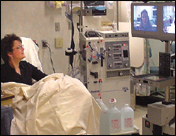Telehealth Networks: Combining Information Technology and Medical Expertise
- Pamela S. Whitten
- Department of Telecommunication, Information Studies, and Media
- College of Communication Arts and Sciences

A telehealth videoconference at Marquette General Health System, Marquette, Michigan.
MSU telecommunication professor Pamela Whitten has spent her professional career combining two challenging fields of study. Dr. Whitten focuses on improving the accessibility and quality of health care by establishing and supporting telehealth networks to meet the needs of rural and underserved residents.
Telehealth networks use technology such as video conferencing, streaming media, and wireless communications to provide patient care over long distances.
One of her current partnerships, the Midwest Alliance for Telehealth and Technology Resources, includes Michigan State University, Marquette General Hospital in Marquette, Michigan, the University of Kansas, and Purdue University.
"Many people in rural areas don't have access to state-of-the-art capabilities in health care or there are economical and logistical hurdles for sustaining long-term care," said Whitten. "This project will enable health organizations across the three states to implement communication technologies that increase access and quality of care."
Susan Makela, Director of Telehealth at Marquette General Health System, was equally enthusiastic about the partnership. "Pam brings her expertise in telehealth and academic research to many of the Upper Peninsula Telehealth Network (UPTN) projects," she said. "This has assisted us in putting the UPTN, with hub operations at Marquette, on the map in regard to telehealth leadership for organizations. Many UP residents now have access to specialty care via the UPTN with grassroots efforts that Pam was involved with. She has provided long-term friendships and partnerships that speak volumes to her personality and people skills."
Whitten has employed a wide range of technologies to deliver health services to urban and rural residents, ranging from videoconferencing over high bandwidth to videophones that operate over simple home-based analog phone lines. She has also incorporated medical peripheral devices that enable health providers to listen to heart sounds or look into patient's ears and throats in real time. Using distance technology, health care providers can assess the patients' appearance and responses to help evaluate symptoms and explore treatment options.
Whitten is also investigating icon- or picture-based health education Web site design for patients with limited computer skills, formal education, or English language comprehension. She is enthusiastic about the future of health communication and the use of communication strategies to inform individual and community decisions that enhance health. "We have two powerful resources—information technology and advanced medical knowledge—that merge to offer improved health care to underserved populations, such as rural residents. As new technology and medicine capabilities develop we will dedicate our efforts to weaving them into our work. Telemedicine is real health care service that can make a difference," she said.
In 2004 the National Library of Medicine and the American Medical Women's Association named Whitten a Michigan "Local Legend," an honor bestowed upon women who have demonstrated commitment, innovation, or creativity in the field of medicine.
- Written by Carla Hills, University Outreach and Engagement